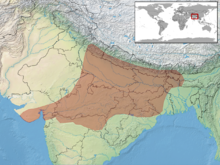The Indian egg-eating snake or Indian egg-eater (Elachistodon westermanni) is a rare species of egg-eating snake in the family Colubridae. The species is endemic to the Indian subcontinent. It is also called Westermann's snake, reflecting its scientific name.[1] The snake belongs to the monotypic genus Elachistodon.[3]
| Indian egg-eating snake | |
|---|---|

| |
| Indian egg-eater at Amravati | |
| Scientific classification | |
| Domain: | Eukaryota |
| Kingdom: | Animalia |
| Phylum: | Chordata |
| Class: | Reptilia |
| Order: | Squamata |
| Suborder: | Serpentes |
| Family: | Colubridae |
| Genus: | Elachistodon Reinhardt, 1863 |
| Species: | E. westermanni
|
| Binomial name | |
| Elachistodon westermanni Reinhardt, 1863
| |

| |
| Synonyms[3] | |
Etymology edit
The specific name, westermanni, is in honor of Dutch zoologist Geraldus Frederick Westermann (1807–1890).[4]
Geographic range edit
The Indian egg-eating snake is found in Bangladesh, India, and Nepal. Recent discoveries of the species come from Maharashtra, Gujarat, Punjab, Madhya Pradesh, Telangana and Karnataka.[5][6][7][8][9]
Habitat edit
The preferred natural habitats of E. westermanni are forest and shrubland, at altitudes of 40–1,000 m (130–3,280 ft).[1]
Description edit
E. westermanni is glossy brown to black, with bluish white flecks posteriorly and a middorsal creamy stripe from neck to tail tip. The head is brown with a black arrow mark. The ventrals are white with brown dots. Adults may attain a total length of 78 cm (31 inches), with a tail 11 cm (4+1⁄4 inches) long.[10]
Behaviour edit
The Indian egg-eating snake is a diurnal[1] or nocturnal, terrestrial species that shows remarkable dexterity in scaling vegetation. When provoked, it raises the anterior portion of the body, forming S-shaped coils as a defensive strategy.[9]
Diet edit
E. westermanni exclusively feeds on bird eggs that lack embryonic growth. It has special adaptations such as vertebral hypapophyses, projections of the cervical vertebrae, that jut into the oesophagus, are enamel-capped, and help in cracking eggs.[10] The only other snakes that share these egg-eating adaptations are in the genus Dasypeltis found in Africa.[11]
Reproduction edit
References edit
- ^ a b c d Srinivasulu, C.; Srinivasulu, B.; Vyas, R.; Thakur, S.; Mohapatra, P.; Giri, V. (2013). "Elachistodon westermanni". IUCN Red List of Threatened Species. 2013: e.T7091A3136878. doi:10.2305/IUCN.UK.2013-1.RLTS.T7091A3136878.en. Retrieved 20 November 2021.
- ^ "Appendices | CITES". cites.org. Retrieved 2022-01-14.
- ^ a b c Boiga westermanni at the Reptarium.cz Reptile Database. Accessed 13 April 2017.
- ^ Beolens, Bo; Watkins, Michael; Grayson, Michael (2011). The Eponym Dictionary of Reptiles. Baltimore: Johns Hopkins University Press. xiii + 296 pp. ISBN 978-1-4214-0135-5. (Elachistodon westermanni, p. 282).
- ^ Mahesh Bilaskar, Santhanankrishnan Babu, Honnavali N. Kumara & Harif Parengal (2018). "First record of the Indian Egg-eater, Elachistodon westermanni REINHARDT, 1863, from Karnataka, India. https://www.zobodat.at/pdf/HER_31_1_2_0108-0110.pdf
- ^ Captain A, Tillack F, Gumprecht A, Dandge P (2005). "First record of Elachistodon westermanni Reinhardt 1863 (Serpentes, Colubridae, Colubrinae) from Maharashtra State, India". Russian Journal of Herpetology. 12 (2): 156–158.
- ^ Nande R, Deshmukh S (2007). "Snakes of Amravati district including Melghat, Maharashtra, with important records of the Indian egg-eater, montane trinket snake and Indian Smooth Snake" (PDF). Zoos' Print Journal. 22 (12): 2920–2924. doi:10.11609/jott.zpj.1653.2920-4. Archived from the original (PDF) on 2016-03-03. Retrieved 2009-07-15.
- ^ Sharma V (2014). "On the distribution of Elachistodon westermanni Reinhardt, 1863 (Serpentes, Colubridae)". Russian Journal of Herpetology. 21 (3): 161–165.
- ^ a b Visvanathan A (2015). "Natural history notes on Elachistodon westermanni Reinhardt, 1863". Hamadryad. 37 (1–2): 132–136.
- ^ a b Boulenger GA (1896). Catalogue of the Snakes in the British Museum (Natural History), Volume III., Containing the Colubridæ (Opisthoglyphæ and Proteroglyphæ) ... London: Trustees of the British Museum (Natural History). (Taylor and Francis, printers). xiv + 727 pp. + Plates I-XXV. (Subfamily Elachistodontinæ, p. 263; Genus Elachistodon, p. 263; species E. westermanni, p. 264).
- ^ Gans, Carl; Oshima, Masamitsu (1952). "Adaptations for egg eating in the snake Elaphe climacophora (Boie)". American Museum Novitates (1571): 1–16. hdl:2246/3997.
External links edit
- Genus information
- Elachistodon westermanni at the Reptarium.cz Reptile Database. Accessed 5 November 2010.
- Animal Diversity Web
Further reading edit
- Boulenger GA (1890). The Fauna of British India, Including Ceylon and Burma. Reptilia and Batrachia. London: Secretary of State for India in Council. (Taylor and Francis, printers). xviii + 541 pp. (Genus Elachistodon, pp. 362–363; E. westermanni, p. 363).
- Günther ACLG (1864). The Reptiles of British India. London: The Ray Society. (Taylor and Francis, printers). xxvii + 452 pp. + Plates I-XXVI. (Elachistodon westermanni, Appendix [p. 444]).
- Reinhardt [JT] (1863). "En ny Slægt af Slangenfamilien Rachiodontidæ ". Oversigt over det Kongelige danske Videnskabernes Selskabs Forhandlinger 1863: 198–210. (Elachistodon, new genus, p. 206; E. westermanni, new species, pp. 206–210 + Figures 1–7). (in Danish and Latin).
- Sharma RC (2003). Handbook: Indian Snakes. Kolkata: Zoological Survey of India. 292 pp. ISBN 978-8181711694.
- Smith MA (1943). The Fauna of British India, Ceylon and Burma, Including the Whole of the Indo-Chinese Sub-region. Reptilia and Amphibia. Vol. III.—Serpentes. London: Secretary of State for India. (Taylor and Francis, printers). xii + 583 pp. (Genus Elachistodon, p. 404; E. westermanni, pp. 404–405, Figure 132).
- Wall F (1913). "A rare Snake Elachistodon westermanni from the Jalpaiguri District". Journal of the Bombay Natural History Society 22 : 400–401.
- Whitaker R, Captain A (2008). Snakes of India: The Field Guide. Chennai: Draco Books. 495 pp. ISBN 978-8190187305.
